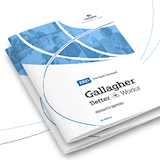
And if leadership RSVPs ‘yes’ to this uniquely timed invitation to reimagine the employee experience (EX), they can realise exceptional advantages for their people and the organisation.
Living through a pandemic has given people a new outlook on the value of relationships, including employees who spend so many waking hours interacting with others. Optimising those interactions and the experiences they create is important. For organisations that unwittingly brought about a disjointed EX in the past, now is the time to reverse course by investing in one that helps their people feel different about work.
An experience that more strongly connects people to their work — and each other — requires effective tools that enable them to bring their best selves to the job. Wherever and whenever work gets done, support for physical, emotional, financial and career wellbeing will inspire performance and improve retention. So, it’s decision-making time. And the choices come down to inaction that’s simplistic and risky, or mitigative actions that are grounded in current realities and future concerns. The first equates vaccines alone with returning to a bygone normalcy — and the second is invested in meeting the challenges ahead by doing things differently. Potential problems related to redundancies, higher taxes, personal and business debt, a renewed fight for talent and new ways of working are not likely to solve themselves.
The accelerated need to join up all ‘parts’ of the EX
An organisational programme that can bring meaningful and sustainable change to the EX has to be led from the top. It’s an essential undertaking that directly affects business survival, growth and prosperity, and treating it as an add-on is exactly what leads to fragmented results and low investment returns. Without leaders carving out time and budget for this consequential priority — and viewing people as pivotal to everything — last year’s learnings become next year’s failings.
Each disconnect that currently exists between HR software platforms and departments, and rhetoric and plain speak, can generate frustrating micro-experiences for employees. The net effect is an EX that’s defined more by roadblocks than smooth passage on an enjoyable journey.
When managing the EX, organisations may encounter size challenges. The bigger their business the more platforms they use for purposes like onboarding, payroll, engagement, learning and development, and retention. Across all sizes, almost a third of HR departments (29%) use 5–10 systems. And organisations with over 500 employees are most likely to rely on more than 10 solutions to manage HR.1
How can employers expect their people to navigate all of these platforms and perform to their best every day?
More often than not, pay cheques motivate people to get out of bed and go to work each day. That’s the reality. But when an EX triggers positive emotions that energise this commitment, the organisation that provides it has good reason to feel confident about their future. People naturally gravitate towards opportunities to be healthier, happier — and more confident about their own futures.
8 influencers of the EX
Approaches to ensuring a great customer experience (CX) and a great EX differ, but there’s some interesting crossover in the challenges they face and the solutions that work. Similar to consumers accustomed to seemingly infinite product and service choices, employees now have broader job options with the increase in home-working. And they’re more inclined to move on, more quickly, to a different organisation if they’re dissatisfied with their current lot.
Thinking of employees as customers can help EX strategies succeed. But what creates an experience that promotes loyalty?

1. Physical and emotional wellbeing
It’s one thing for employers to say their people are their greatest asset. But it’s quite another to actually demonstrate that claim. Designing differentiated approaches to physical and emotional wellbeing acknowledges that people’s needs can be as unique as their fingerprints. And the trend towards health assessments and general practitioner services will help people take better control of their wellbeing, which is crucial to an EX that supports a diverse workforce.2
2. Financial wellbeing
Individualised attention to financial wellbeing is an area for improvement. Social inequality of savings and wealth is worrying in any economic climate — and most employers haven’t been tackling the gap. A huge 84% provide no additional savings plans, on top of money put away for retirement, to help employees increase financial security in the short or medium terms.2
3. Environment and ways of working
A clear vision of what the future of work looks like, including where it takes place, is as essential to the EX as it is to operations. And policies should be just as clearly communicated to employees and fully understood. Properly equipping work locations, whether the home or the office, and making the environment comfortable will help them feel better about work.
4. Technology
Since the first pandemic lockdown, organisations have communicated locally and globally almost exclusively in a 2-D environment. This was possible because attitudes about screen time have taken an extreme turn from the ‘50s, when TV’s introduction was met by parental suspicion: ‘Stop watching so much TV, you’ll get square eyes’. While a flattened experience hasn’t become any healthier, business would have ground to a halt last year without digital infrastructure.
Human beings are still designed to live in 3-D, but a heavy reliance on 2-D communication is practically baked into their DNA. So, organisations must figure out how to intermesh digital and face to- face interactions in a way that’s more personal, meaningful — and seamless.
Getting deep into technology, even if an overhaul is required, is imperative to a better EX. This is what drives faster growth and higher profits, with gains from platform efficiencies happening over time. People will always power progress, and when they feel different about work they become the catalysts for prosperity.
5. Leadership and culture
Leaders guide, land and evangelise change by telling the organisation’s evolving story. As confident and credible voices, they bring clarity of purpose to all who help fulfil it. The stakes couldn’t be higher. Presence or absence of good leadership sits behind the top reasons, after pay, for people staying with or leaving an organisation; in terms of individuals feeling appreciated, valued and simply enjoying work.3
6. Strategy and change management
Having a compelling story that emphasises ‘why’ over ‘what’ — the lasting value of an experience instead of the perceived value of its source — is the place to start when developing a strategy. It answers the questions: why does the organisation exist, and what’s its purpose?
A clearly articulated purpose is the touchstone for everything, from the business strategy and objectives to maintaining a shared focus among an aligned workforce, especially when managing change. People are motivated by knowing their work has meaning beyond driving higher profits. To the extent that leadership communicates this intent and the outcomes, they’ll strengthen a sense of belonging across diverse work groups, whether people work side by side or screen to screen.
7. Career wellbeing
The pandemic has created an opportunity to revisit career structures. Social attitudes and priorities are continuing to change at a faster pace. Organisations benefit from asking themselves: are we diverse and inclusive enough? How strong is our social impact? Considering whether they have any square pegs in round holes is also important. Technology has made the world smaller while increasing the size of the talent pool. Through a competitive approach to career wellbeing, employers will stand out.
8. Reward and benefits
A values-based reward strategy is a new trend that expands the focus beyond pay, bonus, pension and traditional benefits. It’s about being responsible, inclusive, fair and flexible in terms of expectations for work time and support for career wellbeing. Increased talent mobility has emboldened people to seek work outside of their local bubble. And the competitive implications for attraction and retention are enormous.
1. solved, ‘Transforming Employee Experience: A SWOT Analysis of 500 Human Resources Departments’, February 2021
2. Gallagher, ‘Benefits Strategy & Benchmarking Survey — UK Edition’, October 2020
3. Investors in People, Job Exodus Trends, 2019 Employee Sentiment Research



